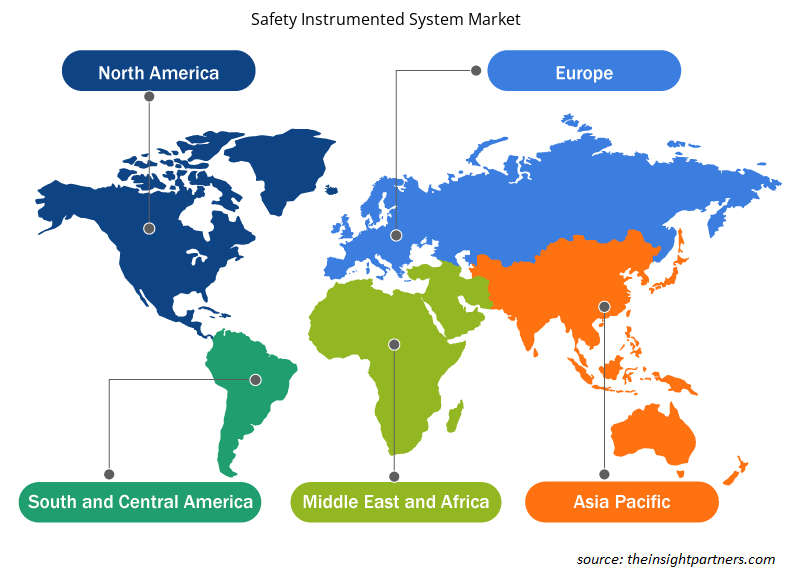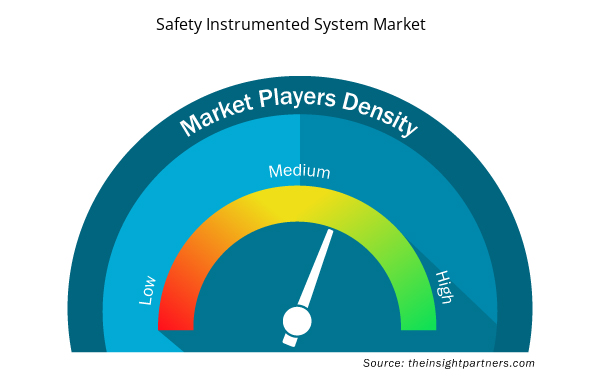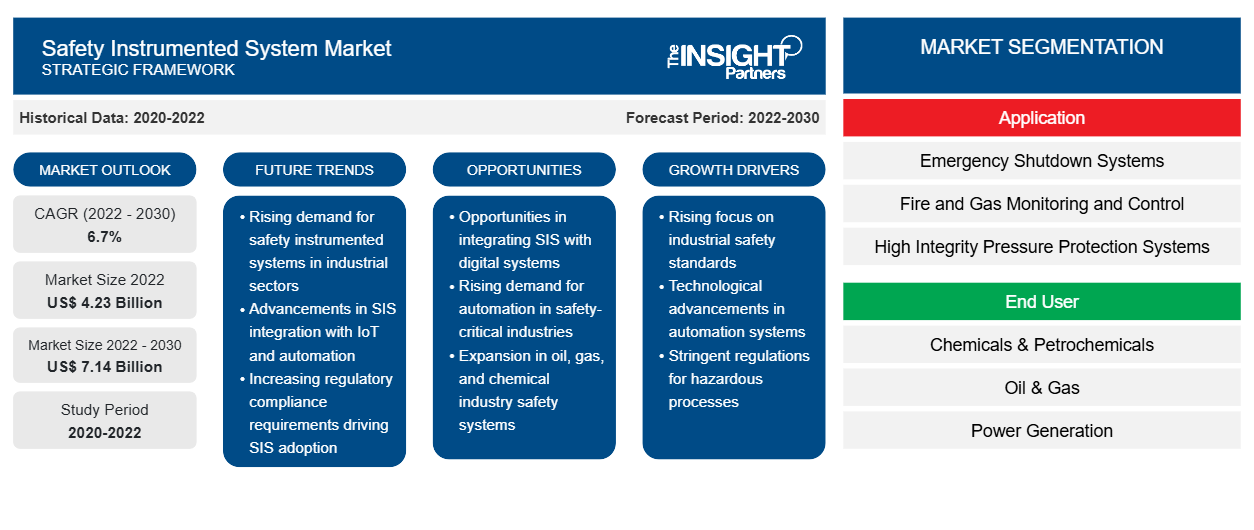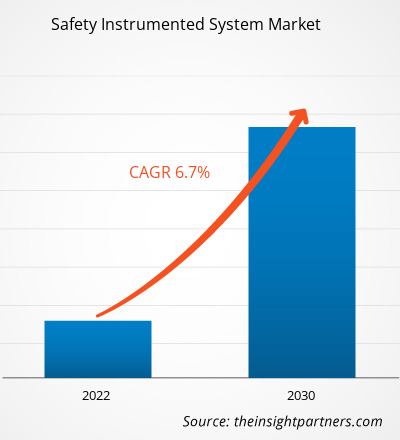[تقرير بحثي] من المتوقع أن ينمو سوق أنظمة السلامة الآلية من 4.23 مليار دولار أمريكي في عام 2022 إلى 7.14 مليار دولار أمريكي بحلول عام 2030؛ ومن المتوقع أن يسجل معدل نمو سنوي مركب بنسبة 6.7٪ من عام 2022 إلى عام 2030.
وجهة نظر المحلل:
إن بناء مصافي النفط والغاز الجديدة وأنشطة التعدين المتنامية في جميع أنحاء العالم هي العوامل الرئيسية التي تغذي نمو سوق أنظمة السلامة الآلية . كما أن التبني المتزايد للوائح ومعايير السلامة يعزز نمو سوق أنظمة السلامة الآلية. علاوة على ذلك، فإن الأتمتة الصناعية المتنامية في صناعة الكيماويات والبتروكيماويات لزيادة كفاءة وسلامة الموظفين تخلق فرصًا أخرى لنمو سوق أنظمة السلامة الآلية. إن الوعي المتزايد بالسلامة عبر الصناعات المختلفة يعمل على تسريع توسع سوق أنظمة السلامة الآلية.
نظرة عامة على السوق:
تُستخدم أنظمة السلامة الآلية (SIS) في العديد من مصانع العمليات لأنها تساعد في اتخاذ إجراءات آلية للحفاظ على المصنع في حالة آمنة عندما تنشأ ظروف غير طبيعية. في حالة حدوث أي اضطراب يمكن أن يؤدي إلى حادث مؤسف، فإن نظام السلامة الآلية (SIS) سيعيد العملية تلقائيًا إلى حالة آمنة ويساعد في منع فقدان الأرواح وتلف الأصول والأضرار البيئية. يمكن أن تحدث العديد من الأحداث الكارثية في مواقع تشغيلية مختلفة في صناعات النفط والغاز والمواد الكيميائية وغيرها من الصناعات التي تتعامل مع الآلات الثقيلة والمواد الكيميائية. يمكن أن تتراوح هذه الأحداث من الحرائق إلى التسريبات التي يمكن أن تؤدي إلى انفجارات، وتتزايد الحاجة إلى أنظمة السلامة المتطورة مثل نظام السلامة الآلية (SIS) في جميع أنحاء العالم.
قم بتخصيص هذا التقرير ليناسب متطلباتك
ستحصل على تخصيص لأي تقرير - مجانًا - بما في ذلك أجزاء من هذا التقرير، أو تحليل على مستوى الدولة، وحزمة بيانات Excel، بالإضافة إلى الاستفادة من العروض والخصومات الرائعة للشركات الناشئة والجامعات
- احصل على أهم اتجاهات السوق الرئيسية لهذا التقرير.ستتضمن هذه العينة المجانية تحليلاً للبيانات، بدءًا من اتجاهات السوق وحتى التقديرات والتوقعات.
محرك السوق:
التوسع المتزايد في صناعة النفط والغاز يدفع نمو سوق أنظمة السلامة الآلية
الولايات المتحدة هي واحدة من أكبر منتجي الغاز الطبيعي في العالم. وفقًا لإدارة معلومات الطاقة الأمريكية (EIA)، أنتجت البلاد حوالي 34،517،798 مليون قدم مكعب (MMcf) من الغاز الطبيعي واستهلكت 30،664،951 مليون قدم مكعب من الغاز الطبيعي في عام 2021. كما صدرت البلاد أيضًا 3،560،818 مليون قدم مكعب من الغاز الطبيعي المسال (LNG). كما أن العديد من مشاريع بناء النفط والغاز الجديدة قيد التنفيذ في جميع أنحاء العالم. في الربع الثاني من عام 2022، بدأت أعمال بناء مشروع مركز التميز لالتقاط الكربون وإزالته في برنابي، كولومبيا البريطانية، كندا. وشمل ذلك بناء مصنع لالتقاط وتخزين ما يصل إلى 2000 طن متري من ثاني أكسيد الكربون يوميًا. وبالمثل، بدأ بناء مشروع مصنع فيستا باسيفيكو للغاز الطبيعي المسال في الربع الثاني من عام 2022، باستثمار قدره 2000 مليون دولار أمريكي. في إطار هذا المشروع، سيتم إنشاء محطة لتصدير الغاز الطبيعي المسال على مساحة 150 هكتارًا في بلدية آهومي، توبولوبامبو، سينالوا، المكسيك. وبالتالي، فإن مثل هذه المشاريع الإنشائية للنفط والغاز من شأنها أن تدفع الطلب على أنظمة السلامة الآلية.
علاوة على ذلك، وفقًا لتقرير إحصاءات صناعة التعدين السويدية لعام 2021، بلغ إنتاج الخام السويدي 88.6 مليون طن متري في عام 2021، بزيادة قدرها 22% منذ عام 2015. كما زاد إنتاج التعدين في أستراليا بنسبة 5.7% في الربع الأول من عام 2023 وفقًا لمكتب الإحصاء الأسترالي. وبالتالي، من المتوقع أن يؤدي نمو إنتاج التعدين في جميع أنحاء العالم إلى زيادة الطلب على الأمن والمراقبة لضمان سلامة الموظفين أو المعدات أو المواد. تعمل هذه الحاجة المتزايدة إلى أنظمة السلامة المجهزة بأجهزة على تعزيز نمو سوق أنظمة السلامة المجهزة بأجهزة.
تقسيم التقرير ونطاقه:
يتم تقسيم سوق أنظمة السلامة الآلية على أساس التطبيق والمستخدم النهائي والجغرافيا. بناءً على التطبيق، يتم تقسيم سوق أنظمة السلامة الآلية إلى أنظمة الإغلاق في حالات الطوارئ، ومراقبة الحرائق والغاز والتحكم فيها، وأنظمة حماية الضغط العالي، وأنظمة إدارة الموقد، والتحكم في آلات التوربينات. حسب المستخدم النهائي، يتم تصنيف سوق أنظمة السلامة الآلية إلى المواد الكيميائية والبتروكيماوية، والنفط والغاز، وتوليد الطاقة، والأدوية، والأغذية والمشروبات، وغيرها. جغرافيًا، يتم تقسيم سوق أنظمة السلامة الآلية إلى أمريكا الشمالية وأوروبا وآسيا والمحيط الهادئ (APAC) والشرق الأوسط وأفريقيا (MEA) وأمريكا الجنوبية (SAM).
التحليل القطاعي:
بناءً على التطبيق، ينقسم سوق أنظمة الأمان المجهزة بالأدوات إلى أنظمة الإغلاق في حالات الطوارئ، ومراقبة الحرائق والغاز والتحكم فيها، وأنظمة حماية الضغط العالي، وأنظمة إدارة الموقد، والتحكم في الآلات التوربينية. احتل قطاع أنظمة الإغلاق في حالات الطوارئ أكبر حصة سوقية لأنظمة الأمان المجهزة بالأدوات في عام 2022 ومن المتوقع أن يسجل أعلى معدل نمو سنوي مركب خلال الفترة 2022-2030. أنظمة الإغلاق في حالات الطوارئ (ESD) هي أنظمة تحكم عالية الموثوقية للصناعات عالية المخاطر مثل النفط والغاز والطاقة النووية مع خطر الانفجار. يساعد النظام في حماية الأفراد والمصنع والبيئة في حالة تجاوز العملية هوامش التحكم.
التحليل الإقليمي:
استحوذت منطقة آسيا والمحيط الهادئ على أكبر حصة سوقية لأنظمة السلامة الآلية في عام 2022. تشهد المنطقة نموًا هائلاً في صناعة الكيماويات والأدوية. يعمل اللاعبون في السوق في هذه المنطقة باستمرار على توسيع مرافق التصنيع الخاصة بهم. على سبيل المثال، في ديسمبر 2022، أعلنت شركة Balaxi Pharmaceuticals أنها بدأت في بناء منشأة جديدة لتصنيع الأدوية في تيلانجانا، الهند. استثمرت الشركة ما يقرب من 10.29 مليون دولار أمريكي (85 كرور روبية هندية) في هذا المشروع. سيساعد مرفق الإنتاج الجديد الشركة على دخول الأسواق الأوروبية وتعزيز الهوامش في الأسواق الحالية. وبالمثل، في سبتمبر 2021، أعلنت شركة Hanwha Corp. عن خطتها لبناء مصنع لإنتاج حمض النيتريك بحلول عام 2024. سيوفر هذا المصنع طاقة سنوية تبلغ 400000 طن متري في مجمع يوسو الصناعي، كوريا الجنوبية. لهذا، ستستثمر الشركة 162 مليون دولار أمريكي (190 مليار وون).
وبالتالي، فإن العدد المتزايد من مرافق الإنتاج الجديدة في المنطقة من شأنه أن يزيد الطلب على أنظمة السلامة الآلية، حيث يساعد ذلك على منع أي حوادث في المصنع، مما يدفع نمو سوق أنظمة السلامة الآلية.
تحليل اللاعب الرئيسي:
تعد شركة ABB Ltd، وشركة Applied Control Engineering Inc، وشركة AVEVA Group plc، وشركة Emerson Electric Co، وشركة HIMA، وشركة Honeywell International، وشركة Rockwell Automation Inc، وشركة Schneider Electric، وشركة Siemens AG، وشركة Yokogawa Electric Corporation من اللاعبين الرئيسيين في سوق أنظمة الأجهزة الأمنية الموضحة في التقرير.
رؤى إقليمية حول سوق أنظمة السلامة الآلية
لقد قام المحللون في Insight Partners بشرح الاتجاهات والعوامل الإقليمية المؤثرة على سوق أنظمة السلامة الآلية طوال فترة التوقعات بشكل شامل. يناقش هذا القسم أيضًا قطاعات سوق أنظمة السلامة الآلية والجغرافيا في جميع أنحاء أمريكا الشمالية وأوروبا ومنطقة آسيا والمحيط الهادئ والشرق الأوسط وأفريقيا وأمريكا الجنوبية والوسطى.

- احصل على البيانات الإقليمية المحددة لسوق أنظمة السلامة الآلية
نطاق تقرير سوق أنظمة السلامة الآلية
| سمة التقرير | تفاصيل |
|---|---|
| حجم السوق في عام 2022 | 4.23 مليار دولار أمريكي |
| حجم السوق بحلول عام 2030 | 7.14 مليار دولار أمريكي |
| معدل النمو السنوي المركب العالمي (2022 - 2030) | 6.7% |
| البيانات التاريخية | 2020-2022 |
| فترة التنبؤ | 2022-2030 |
| القطاعات المغطاة | حسب الطلب
|
| المناطق والدول المغطاة | أمريكا الشمالية
|
| قادة السوق وملفات تعريف الشركات الرئيسية |
|
كثافة اللاعبين في السوق: فهم تأثيرها على ديناميكيات الأعمال
يشهد سوق أنظمة السلامة الآلية نموًا سريعًا، مدفوعًا بالطلب المتزايد من المستخدم النهائي بسبب عوامل مثل تفضيلات المستهلكين المتطورة والتقدم التكنولوجي والوعي المتزايد بفوائد المنتج. ومع ارتفاع الطلب، تعمل الشركات على توسيع عروضها والابتكار لتلبية احتياجات المستهلكين والاستفادة من الاتجاهات الناشئة، مما يؤدي إلى زيادة نمو السوق.
تشير كثافة اللاعبين في السوق إلى توزيع الشركات أو المؤسسات العاملة في سوق أو صناعة معينة. وهي تشير إلى عدد المنافسين (اللاعبين في السوق) الموجودين في مساحة سوق معينة نسبة إلى حجمها أو قيمتها السوقية الإجمالية.
الشركات الرئيسية العاملة في سوق أنظمة السلامة الآلية هي:
- شركة أيه بي بي المحدودة
- هندسة التحكم التطبيقي
- مجموعة أفيفا المحدودة
- شركة إيمرسون للكهرباء
- HIMA، شركة هانيويل الدولية
إخلاء المسؤولية : الشركات المذكورة أعلاه ليست مرتبة بأي ترتيب معين.

- احصل على نظرة عامة على أهم اللاعبين الرئيسيين في سوق أنظمة السلامة الآلية
التطورات الأخيرة:
يعتمد المشاركون في سوق أنظمة السلامة الآلية بشكل كبير على الاستراتيجيات العضوية وغير العضوية. فيما يلي بعض التطورات الرئيسية الأخيرة في السوق:
- في مايو 2022، قدمت إيمرسون TopWorxTM DX PST مع HART 7. توفر الوحدات بيانات صمامات ومعلومات تشخيصية قيمة، مما يتيح التحول الرقمي لتطبيقات العمليات. يتكامل DX PST الجديد بسلاسة مع الصمامات وأنظمة التحكم الحالية، مما يتيح للمشغلين الوصول إلى بيانات الصمامات والاتجاهات والتشخيصات المهمة التي يمكن استخدامها للتنبؤ بالصيانة وجدولتها. DX PST قادر على مستوى سلامة السلامة 3 (SIL 3)، وهو متاح مع صمام الملف اللولبي 2oo2 أو 2oo3 المدمج عند إقرانه بنظام التحكم المتقدم في التكرار من سلسلة ASCOTM (ARCS) لتعزيز السلامة بشكل أكبر وفتح المحطات الطرفية التي تسمح بجهاز إرسال ضغط إضافي إلى جانب مفتاحي ضغط.
- في مارس 2022، حصلت شركة INTECH على عقد لتوفير نظام حماية الضغط عالي الجودة (HIPPS) لحماية البنية التحتية لتجميع النفط في حقل نفط رئيسي في الشرق الأوسط. وبموجب هذا العقد، سعت شركات حقول النفط في الشرق الأوسط إلى الحصول على خبرة INTECH في تصنيع وتركيب حزم IOPPS في اتجاه مجرى الأنابيب لحماية خطوط الأنابيب الرئيسية ومحطات إزالة الغاز من الضغط الزائد المحتمل.
- في نوفمبر 2020، أطلقت شركة ABB منتج ABB Ability Safety Plus للرافعات، وهو عبارة عن مجموعة من منتجات سلامة الرافعات في المناجم توفر أعلى مستوى من سلامة الأفراد والمعدات المتاحة لصناعة التعدين. تتضمن المنتجات جهاز مراقبة الرافعات (SPHM) وجهاز حماية الرافعات (SPHP) ونظام الفرامل (SPBS)، بما في ذلك أنظمة الفرامل الهيدروليكية (SBH).
- التحليل التاريخي (سنتان)، السنة الأساسية، التوقعات (7 سنوات) مع معدل النمو السنوي المركب
- تحليل PEST و SWOT
- حجم السوق والقيمة / الحجم - عالميًا وإقليميًا وقطريًا
- الصناعة والمنافسة
- مجموعة بيانات Excel



Report Coverage
Revenue forecast, Company Analysis, Industry landscape, Growth factors, and Trends

Segment Covered
This text is related
to segments covered.

Regional Scope
North America, Europe, Asia Pacific, Middle East & Africa, South & Central America

Country Scope
This text is related
to country scope.
الأسئلة الشائعة
The US held the largest safety instrumented system market share in 2022.
The incremental growth expected to be recorded for the safety instrumented system market during the forecast period is US$ 2.90 billion.
Rising expansion in oil & gas industry and growing adoption of safety regulations and standards are the major factors that propel the safety instrumented system market.
The key players holding majority shares in the safety instrumented system market are Rockwell Automation Inc, Honeywell International, Emerson Electric Co, Yokogawa Electric Corporation, and ABB Ltd.
Asia Pacific is anticipated to grow with the highest CAGR over the forecast period.
The Safety instrumented system market is expected to reach US$ 7.14 billion by 2030.
Growing awareness of safety across different industries is anticipated to play a significant role in the safety instrumented system market in the coming years.
The safety instrumented system market was estimated to be US$ 4.23 billion in 2022 and is expected to grow at a CAGR of 6.7 % during the forecast period 2023 - 2030.
Trends and growth analysis reports related to Electronics and Semiconductor : READ MORE..
The List of Companies - Safety Instrumented System Market
- ABB Ltd
- Applied Control Engineering Inc
- AVEVA Group plc
- Emerson Electric Co
- HIMA, Honeywell International
- Rockwell Automation Inc
- Schneider Electric
- Siemens AG
- Yokogawa Electric Corporation
The Insight Partners performs research in 4 major stages: Data Collection & Secondary Research, Primary Research, Data Analysis and Data Triangulation & Final Review.
- Data Collection and Secondary Research:
As a market research and consulting firm operating from a decade, we have published and advised several client across the globe. First step for any study will start with an assessment of currently available data and insights from existing reports. Further, historical and current market information is collected from Investor Presentations, Annual Reports, SEC Filings, etc., and other information related to company’s performance and market positioning are gathered from Paid Databases (Factiva, Hoovers, and Reuters) and various other publications available in public domain.
Several associations trade associates, technical forums, institutes, societies and organization are accessed to gain technical as well as market related insights through their publications such as research papers, blogs and press releases related to the studies are referred to get cues about the market. Further, white papers, journals, magazines, and other news articles published in last 3 years are scrutinized and analyzed to understand the current market trends.
- Primary Research:
The primarily interview analysis comprise of data obtained from industry participants interview and answers to survey questions gathered by in-house primary team.
For primary research, interviews are conducted with industry experts/CEOs/Marketing Managers/VPs/Subject Matter Experts from both demand and supply side to get a 360-degree view of the market. The primary team conducts several interviews based on the complexity of the markets to understand the various market trends and dynamics which makes research more credible and precise.
A typical research interview fulfils the following functions:
- Provides first-hand information on the market size, market trends, growth trends, competitive landscape, and outlook
- Validates and strengthens in-house secondary research findings
- Develops the analysis team’s expertise and market understanding
Primary research involves email interactions and telephone interviews for each market, category, segment, and sub-segment across geographies. The participants who typically take part in such a process include, but are not limited to:
- Industry participants: VPs, business development managers, market intelligence managers and national sales managers
- Outside experts: Valuation experts, research analysts and key opinion leaders specializing in the electronics and semiconductor industry.
Below is the breakup of our primary respondents by company, designation, and region:

Once we receive the confirmation from primary research sources or primary respondents, we finalize the base year market estimation and forecast the data as per the macroeconomic and microeconomic factors assessed during data collection.
- Data Analysis:
Once data is validated through both secondary as well as primary respondents, we finalize the market estimations by hypothesis formulation and factor analysis at regional and country level.
- Macro-Economic Factor Analysis:
We analyse macroeconomic indicators such the gross domestic product (GDP), increase in the demand for goods and services across industries, technological advancement, regional economic growth, governmental policies, the influence of COVID-19, PEST analysis, and other aspects. This analysis aids in setting benchmarks for various nations/regions and approximating market splits. Additionally, the general trend of the aforementioned components aid in determining the market's development possibilities.
- Country Level Data:
Various factors that are especially aligned to the country are taken into account to determine the market size for a certain area and country, including the presence of vendors, such as headquarters and offices, the country's GDP, demand patterns, and industry growth. To comprehend the market dynamics for the nation, a number of growth variables, inhibitors, application areas, and current market trends are researched. The aforementioned elements aid in determining the country's overall market's growth potential.
- Company Profile:
The “Table of Contents” is formulated by listing and analyzing more than 25 - 30 companies operating in the market ecosystem across geographies. However, we profile only 10 companies as a standard practice in our syndicate reports. These 10 companies comprise leading, emerging, and regional players. Nonetheless, our analysis is not restricted to the 10 listed companies, we also analyze other companies present in the market to develop a holistic view and understand the prevailing trends. The “Company Profiles” section in the report covers key facts, business description, products & services, financial information, SWOT analysis, and key developments. The financial information presented is extracted from the annual reports and official documents of the publicly listed companies. Upon collecting the information for the sections of respective companies, we verify them via various primary sources and then compile the data in respective company profiles. The company level information helps us in deriving the base number as well as in forecasting the market size.
- Developing Base Number:
Aggregation of sales statistics (2020-2022) and macro-economic factor, and other secondary and primary research insights are utilized to arrive at base number and related market shares for 2022. The data gaps are identified in this step and relevant market data is analyzed, collected from paid primary interviews or databases. On finalizing the base year market size, forecasts are developed on the basis of macro-economic, industry and market growth factors and company level analysis.
- Data Triangulation and Final Review:
The market findings and base year market size calculations are validated from supply as well as demand side. Demand side validations are based on macro-economic factor analysis and benchmarks for respective regions and countries. In case of supply side validations, revenues of major companies are estimated (in case not available) based on industry benchmark, approximate number of employees, product portfolio, and primary interviews revenues are gathered. Further revenue from target product/service segment is assessed to avoid overshooting of market statistics. In case of heavy deviations between supply and demand side values, all thes steps are repeated to achieve synchronization.
We follow an iterative model, wherein we share our research findings with Subject Matter Experts (SME’s) and Key Opinion Leaders (KOLs) until consensus view of the market is not formulated – this model negates any drastic deviation in the opinions of experts. Only validated and universally acceptable research findings are quoted in our reports.
We have important check points that we use to validate our research findings – which we call – data triangulation, where we validate the information, we generate from secondary sources with primary interviews and then we re-validate with our internal data bases and Subject matter experts. This comprehensive model enables us to deliver high quality, reliable data in shortest possible time.


 احصل على عينة مجانية لهذا التقرير
احصل على عينة مجانية لهذا التقرير